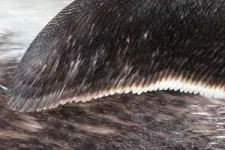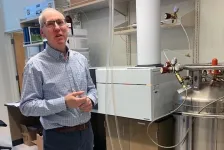(Press-News.org) Your morning cereal, a jar of nuts, the sands of distant planets, and even the concrete in your city are all examples of granular systems surrounding us. And such systems are harboring secrets that could change the way we mix things up.
In a new paper published in the journal Proceedings of the National Academy of Sciences (PNAS), scientists at the University of Rochester, including Rachel Glade, an assistant professor of earth and environmental sciences and of mechanical engineering; Fernando David Cúñez, a former postdoctoral research associate in Glade’s lab and now a postdoctoral research associate at Rochester Institute of Technology; and Div Patel ’24, studied granular materials and uncovered the unexpected role that grain shape plays in the behavior of granular systems.
“Granular materials have peculiar behaviors,” Cúñez says, “but we don’t know a lot about exactly how they behave because their behavior depends on so many different circumstances.”
The Brazil Nut Effect
Granular materials such as cereal, pharmaceuticals, sand, and concrete commonly organize in such a way that grains segregate according to size rather than uniformly mixing. For example, in a jar of nuts the largest nuts are commonly found at the top, a phenomenon known as “the Brazil Nut Effect.” The Brazil Nut Effect can be a nuisance to many industries, including food and medicine, because it prevents uniform mixing. It also has influences in nature, where grain segregation can change the dynamics of geohazards like landslides, erosion, and debris flows.
While the phenomenon is well known, it is not fully understood. Researchers have also traditionally focused on the size of grains, with most previous studies assuming that grains are spherical—a uniformity that rarely mirrors reality.
Shape-shifting dynamics
Glade and her team used advanced computer simulations comparing mixtures of spheres with mixtures of spheres and cubes in a rotating drum and in a river-like setup to investigate how grain shape affects segregation in both dry and wet conditions, respectively. Their research revealed that even small differences in grain shape can significantly alter the dynamics of grain segregation.
Specifically, the researchers found the following patterns in the dry-system mixtures:
In a mixture of different-sized spheres: segregation increases, with more of the larger spheres rising to the top, when the ratio between large-volume spheres and small-volume spheres is greater.
In a mixture of spheres of the same size plus larger cubes: the segregation tends to be the same as the spheres-only case, with the larger spheres rising to the top.
In a mixture of spheres of the same size plus smaller cubes: the segregation tends to decrease, with most of the larger spheres rising to the top but to a lesser extent than in the spheres-only mixture.
Interestingly, in a fluid system, the trend shifts to the opposite:
In a mixture of spheres of the same size plus smaller cubes: the smaller cubes move to the top.
“One way to think of it is that grain shape changes segregation both quantitatively—in the dry drum case, cubes decrease the amount of segregation—and qualitatively—in the wet river case, cubes change the patterns of segregation,” Glade says.
Reshaping industry and nature
Future research will explore why these changes in segregation occur. The researchers surmise that it’s likely due to several factors, including forces exerted on the different particles that make them stick together and resist movement in distinct ways.
Regardless, the study shows how important grain shape is across various domains.
Highlighting the broader implications, Glade says, “our work demonstrates the importance of interdisciplinary research, drawing inspiration from physics, engineering, and earth science. This collaboration paves the way for future work to better understand and predict geohazards, alleviate segregation issues in industrial flows, and enhance our understanding of granular materials on Earth and other planets.”
END
Reshaping our understanding of granular systems
Rochester researchers are uncovering the unexpected role of grain shape in the mixing of granular systems such as pharmaceuticals, cereal, and landslides.
2024-02-12
ELSE PRESS RELEASES FROM THIS DATE:
Can hydrogels help mend a broken heart?
2024-02-12
You can mend a broken heart this valentine’s day now that researchers invented a new hydrogel that can be used to heal damaged heart tissue and improve cancer treatments.
University of Waterloo chemical engineering researcher Dr. Elisabeth Prince teamed up with researchers from the University of Toronto and Duke University to design the synthetic material made using cellulose nanocrystals, which are derived from wood pulp. The material is engineered to replicate the fibrous nanostructures and properties of human tissues, thereby recreating its unique biomechanical properties.
"Cancer is a diverse disease and two patients with the same type of cancer will often respond ...
New study finds that pregnancy complications can also affect child’s health later in life
2024-02-12
Hypertensive disorders of pregnancy (HDP) and gestational diabetes (GDM) are two of the most common pregnancy complications and put pregnant people at increased risk of developing cardiovascular disease later in life.
Now, in a new study to be presented today at the Society for Maternal-Fetal Medicine’s (SMFM) annual meeting, The Pregnancy Meeting™, researchers will unveil findings that suggest these pregnancy complications may also result in worse cardiovascular health for the child.
In a secondary analysis of 3,317 maternal-child pairings from the prospective Hyperglycemia ...
Scientists discover biological mechanism of hearing loss caused by loud noise – and find a way to prevent it
2024-02-12
Anyone who has ever been to a loud concert knows the feeling of ringing ears. Some people experience temporary or even permanent hearing loss or drastic changes in their perception of sound after the loud noises stop. Thanos Tzounopoulos, Ph.D., director of the Pittsburgh Hearing Research Center at the University of Pittsburgh School of Medicine has focused his scientific career on investigating how hearing works and developing ways to treat tinnitus and hearing loss.
In a paper published today in ...
Widespread machine learning methods behind ‘link prediction’ are performing very poorly
2024-02-12
As you scroll through any social media feed, you are likely to be prompted to follow or friend another person, expanding your personal network and contributing to the growth of the app itself. The person suggested to you is a result of link prediction: a widespread machine learning (ML) task that evaluates the links in a network — your friends and everyone else’s — and tries to predict what the next links will be.
Beyond being the engine that drives social media expansion, link prediction is also used in a wide range of scientific research, such as predicting the interaction between genes and proteins, and is used by researchers as a benchmark for ...
The hidden rule for flight feathers—and how it could reveal which dinosaurs could fly
2024-02-12
Birds can fly— at least, most of them can. Flightless birds like penguins and ostriches have evolved lifestyles that don’t require flight. However, there’s a lot that scientists don’t know about how the wings and feathers of flightless birds differ from their airborne cousins. In a new study in the journal PNAS, scientists examined hundreds of birds in museum collections and discovered a suite of feather characteristics that all flying birds have in common. These “rules” provide clues as to how the dinosaur ancestors of modern birds first evolved the ability to fly, ...
Machine learning promises to accelerate metabolism research
2024-02-12
A new study shows that it is possible to use machine learning and statistics to address a problem that has long hindered the field of metabolomics: large variations in the data collected at different sites.
“We don’t always know the source of the variation,” said Daniel Raftery, professor of anesthesiology and pain medicine at the University of Washington School of Medicine in Seattle. “It could be because the subjects are different with different genetics, diets and environmental exposures. Or it could be the way samples were collected and ...
Researchers uncover a key link in legume plant-bacteria symbiosis
2024-02-12
Legume plants have the unique ability to interact with nitrogen-fixing bacteria in the soil, known as rhizobia. Legumes and rhizobia engage in symbiotic relations upon nitrogen starvation, allowing the plant to thrive without the need for externally supplied nitrogen. Symbiotic nodules are formed on the root of the plant, which are readily colonized by nitrogen-fixing bacteria. The cell-surface receptor SYMRK (symbiosis receptor-like kinase) is responsible for mediating the symbiotic signal from rhizobia perception to formation of the nodule. ...
Genetic analysis and archaeological insight combine to reveal the ancient origins of the fallow deer
2024-02-12
Modern populations of fallow deer possess hidden cultural histories dating back to the Roman Empire which ought to be factored into decisions around their management and conservation.
New research, bringing together DNA analysis with archaeological insights, has revealed how fallow deer have been repeatedly moved to new territories by humans, often as a symbol of colonial power or because of ancient cultures and religions.
The results show that the animal was first introduced into Britain by the Romans ...
Researchers studying ocean transform faults, describe a previously unknown part of the geological carbon cycle
2024-02-12
Woods Hole, Mass. (February 12, 2024) – Studying a rock is like reading a book. The rock has a story to tell, says Frieder Klein, an associate scientist in the Marine Chemistry & Geochemistry Department at the Woods Hole Oceanographic Institution (WHOI).
The rocks that Klein and his colleagues analyzed from the submerged flanks of the St. Peter and St. Paul Archipelago in the St. Paul’s oceanic transform fault, about 500 km off the coast of Brazil, tells a fascinating and previously unknown story about parts of the geological ...
Salt substitutes help to maintain healthy blood pressure in older adults
2024-02-12
The replacement of regular salt with a salt substitute can reduce incidences of hypertension, or high blood pressure, in older adults without increasing their risk of low blood pressure episodes, according to a recent study in the Journal of the American College of Cardiology. People who used a salt substitute had a 40% lower incidence and likelihood of experiencing hypertension compared to those who used regular salt.
According to the World Health Organization, hypertension is the leading risk factor for cardiovascular disease and mortality. It affects over 1.4 billion adults and results in 10.8 million deaths per year worldwide. One of the ...
LAST 30 PRESS RELEASES:
How cells balance their protein levels
Nirsevimab vs RSVpreF vaccine for RSV–related hospitalization in newborns
Effectiveness and impact of maternal RSV immunization and nirsevimab on medically attended RSV in US children
AI gives scientists a boost, but at the cost of too many mediocre papers
Next-generation vision model maps tree growth at sub-meter precision
Genes aren’t destiny for inherited blindness, study shows
MIT study: High-fat diets make liver cells more likely to become cancerous
Exposure to multiple fine particulate matter components and incident depression in the US Medicare population
Risk of burdensome health care spending over time in the US
Nirsevimab against hospitalizations and emergency department visits for lower respiratory tract infection in infants
New microfluidics technology enables highly uniform DNA condensate formation
A new strategy for immune tolerance
Super Mario Bros. help fight burnout: New study links classic games to boosted happiness
Deepest gas hydrate cold seep ever discovered in the arctic: International research team unveils Freya Hydrate Mounds at 3,640 m depth.
Integrating light and structure: Smarter mapping for fragile wetland ecosystems
ACA-SIM: A robust way to decode satellite signals over complex waters
Probiotics can restore gut microbiome in breastfed infants
AI could help predict nutrition risks in ICU patients, study finds
Federal EITC has unexpected result, researchers say – it decreases domestic violence
Researchers identify gene that calms the mind and improves attention in mice
Artificial metabolism turns waste CO2 into useful chemicals
Ancient sea anemone sheds light on animal cell type evolution
Begging gene leads to drone food
How climate policies that incentivize and penalize can drive the clean energy transition
Can community awareness campaigns in low-resource areas improve early diagnosis of colorectal cancer?
Stardust study resets how life’s atoms spread through space
Practical education: Clinical scenario-based program development
The impact of family dynamics on eating behaviour – how going home for Christmas can change how you eat
Tracing the quick synthesis of an industrially important catalyst
New software sheds light on cancer’s hidden genetic networks
[Press-News.org] Reshaping our understanding of granular systemsRochester researchers are uncovering the unexpected role of grain shape in the mixing of granular systems such as pharmaceuticals, cereal, and landslides.








